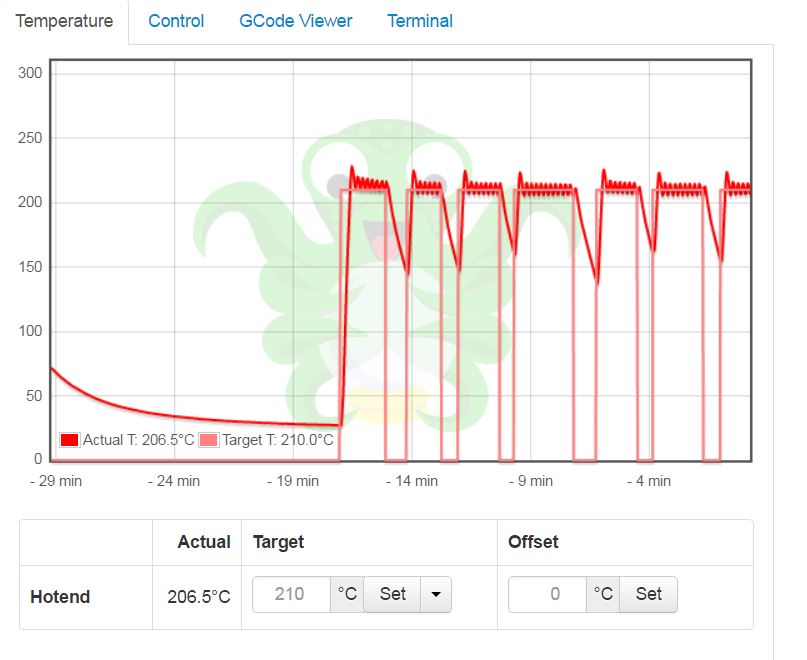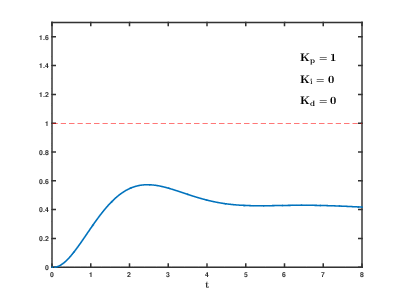hello, playing around with PID tuning. I thought I read somewhere if overshoot and oscillating wildly then increase the integral value. I did that along other combination as well but it seems the pattern is unchanged regardless of what PID value I change… Could use some help here. thx
If it oscillates you need to trim down proportional gain. Integral term is to reduce steady-state error. http://www.csimn.com/CSI_pages/PIDforDummies.html
But most firmwares do have self-tuning feature (M303).
It appears the RepRap wiki says that too, and I’m pretty sure that’s wrong advice. Increasing integral tends to increase the intensity and duration of ringing.
Here’s a working guide if you still want to manually tune, vs. using an auto tune.
I have had the best luck with the the Wikipedia method. FYI you don’t need P, I, and D to balance a temp, though the combination of all three gives the best results. You can look at each one individually to limit fighting too many variables at once.
Start with p at 1 and I and D at zero:
1.) Adjust P value up from 1 to get a good heat up time (note this will yield an overshoot)
2.) Adjust I up from zero until the average of the ossilation is around the target temp.
3.) Adjust D up from zero to dampen the slope of the ossilation until you maintain a steady temp.
I also do my I and D tuning with my part cooling fan at 15% so I know I can maintain steady temps with part cooling on. I don’t do it while tuning P because normally you don’t have part cooling on for the first layer when the P component has the largest effect during initial heat-up.
@Eclsnowman , given that Marlin basically locks you out whenever it can’t reach temp - do you just reset the board, generally in order to try again?
@ThantiK Marlin Auto PID tuning works so well I always just used it, then tweaked the values if needed.
I have not had similar experiences with Smoothieware Auto PID tune especially on a heavy bed. I ended up with ossilation still. I tried increasing D on a smoothieware Autotune, but still got ossilation (P value in the auto tune was likely too aggressive). That’s when I had to learn to tune it by hand. It actually goes very fast doing I and D, tuning P… not so much since it takes a long time for my 1/4" thick 17"x17" HercuLien bed to cool back down to take another run at it.
Thanks @Eclsnowman was very frustrating before… now I think I made good progress  will keep tuning it.
will keep tuning it.
missing/deleted image from Google+
I must have gotten lucky with my bed auto tune. My oscillation is about 0.1° most of the time. I don’t remember if I did any value fiddling or not.
@Step_Cia looking better, looks like on the two runs before the final one you I value was too high causing the ossilation to settle above the setpoint. Also your overshoot is looking a little to high for my liking. Maybe tone down the P value a bit to limit the overshoot.
But progress is being made 
well this is a curve ball… fire the machine again this morning and the fluctuation return  curious so I ran M303 and check the PID number (roughly the same as before) so I heat up the heater to 210c and it is stable again without me changing any PID number…
curious so I ran M303 and check the PID number (roughly the same as before) so I heat up the heater to 210c and it is stable again without me changing any PID number…
missing/deleted image from Google+
I wonder if doing M303 with hotend around 200c vs room temperature makes difference? I M303 when it was still around 200c
It could be your thermistor setting in the firmware, might just be the wrong thermistor selected or installed.

